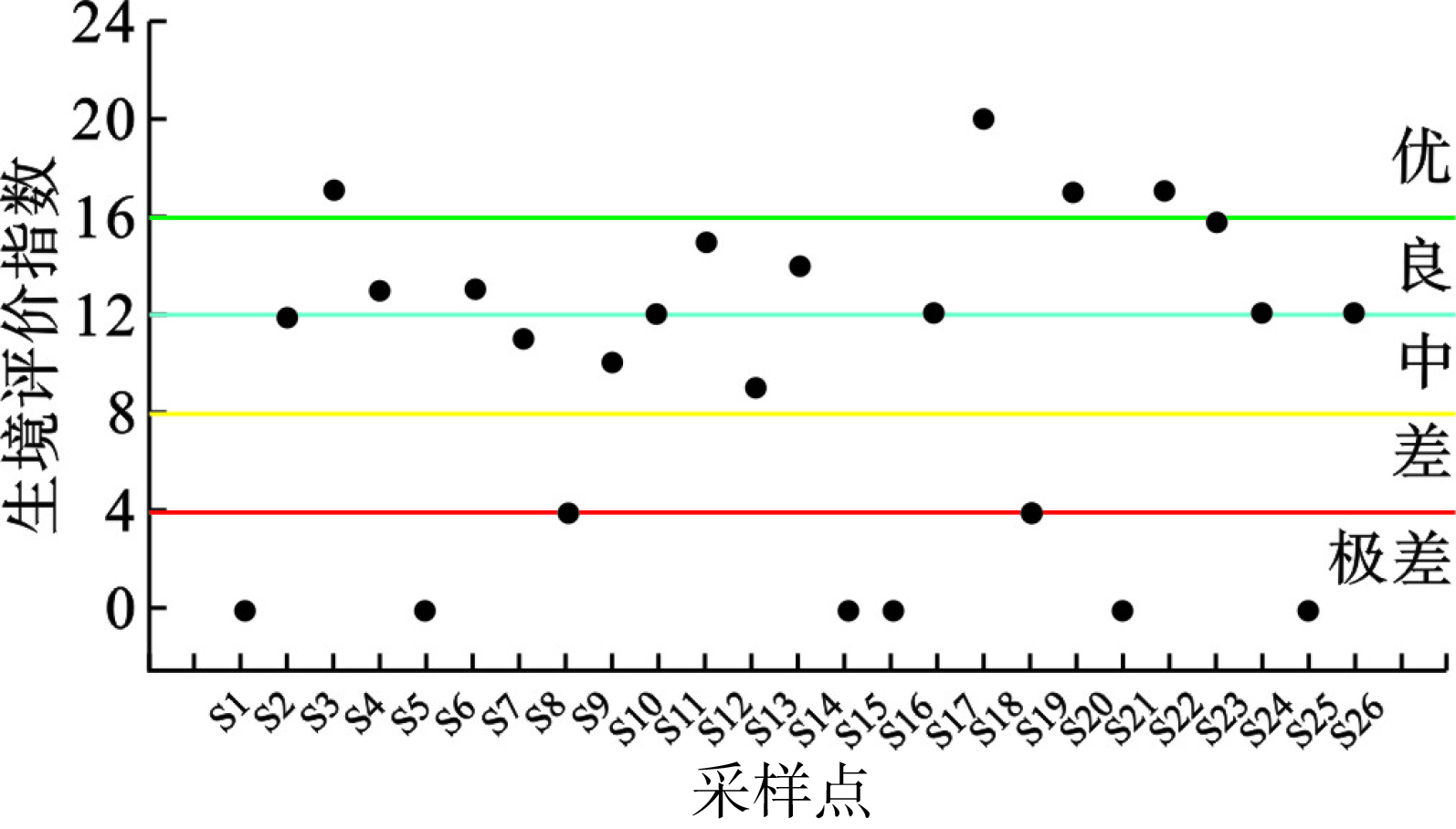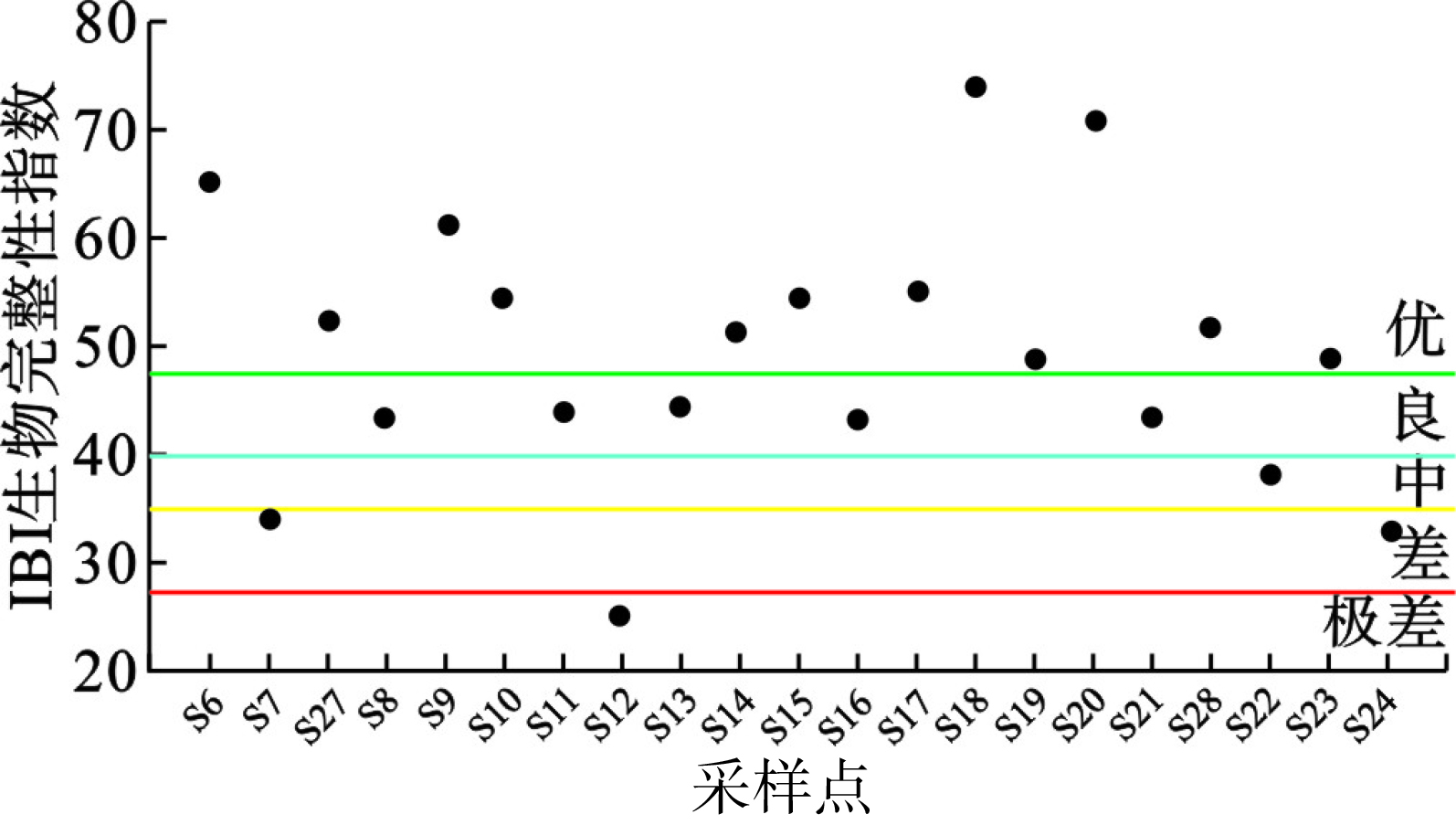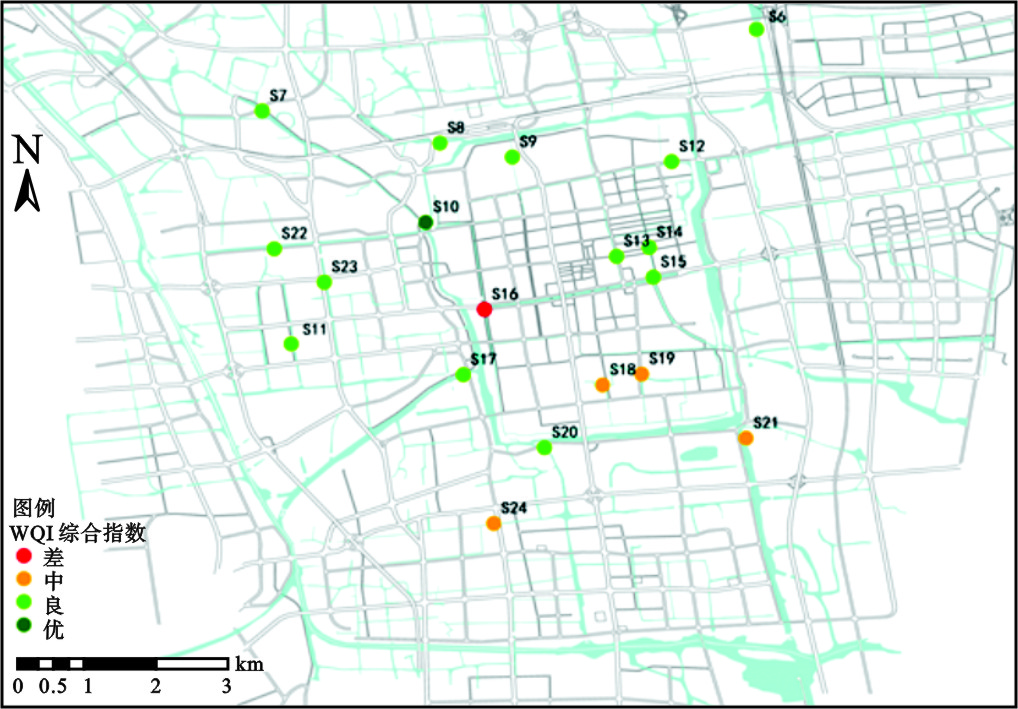-
城市河道的生态建设与水环境保护是影响我国城市长期发展的重要因素。目前城市河道生态环境质量评价技术体系的研究和应用都还比较缺乏,制约了我国对城市水生态环境的保护和管理。
目前,国内外的城市河道生态环境质量评价主要是借鉴流域自然河流水生态环境质量的评价方法,还没有一套比较成熟与完善的方法体系,且大多侧重单一要素,普适性较差,不同城市之间的评价结果难以进行对比。其中美国的生物完整性指数评价方法(index of biotic integrity,IBI)[1-2]是比较常用的城市河道生态环境质量评价方法,在巴西[3]、韩国[4]和比利时[5]等国家的河流生态监测及水环境状况评价中都有广泛的应用。底栖动物IBI指数也被应用在我国的昆明市[6]、上海市[7]和广州市[8]城市河道的河流生态系统状况和健康评价中。苏瑶等[9]利用微生物IBI指数对浙江省内的5条城市河道进行了水生态系统健康评价。刘麟菲等[10]结合鱼类和底栖动物IBI指数对济南市城市河道水体健康进行评价。但是,美国IBI评价体系的核心是评价水生生物群落的完整性,借助生物群落结构变化来反映水体和生境质量的优劣,生境要素和水质理化要素作为胁迫因子进行研究但是不参与水生态环境质量的评价。而在最新的研究中,KIM et al[11]结合鱼类IBI指数、水质综合指标(包括总氮、总磷和化学需氧量等指标)和栖息地指标对韩国的城市河道生态环境质量进行评价。我国也有学者基于欧盟水框架指令(water framework directive,WFD)评估方法同时考虑水质、栖息地质量和鱼类生物指标对郑州市河道的生态环境进行评价[12]。徐后涛[13]以水质、生态系统和生态景观3类要素构建了河道生态健康评价体系对上海市52条中小河道进行生态健康基本状况和生态治理效果进行评价。在目前的评价方法中水质指标往往采用单因子污染指数评价方法,该方法计算简单但是难以反映整体水质变化。同时大多数研究的生境指标不够全面,对流速、水量、河道底质、形状和河岸稳定性等因素缺乏综合考虑。另外,在水生生物的指标选择上应考虑易于监测评价的指标。针对当前城市河道生态环境评价指标体系不完善、评价方法普适性差和评估难度大等问题,亟需构建多要素、具有代表性的城市河道生态环境评价指标体系和评估方法,在确保科学的基础上还要尽量减少监测成本和降低评估难度。
本研究以我国东部平原河网的城市河道为例,综合考虑水质、生境和水生生物3大要素,结合城市河道生态环境的实际情况,构建了由河道形态与结构、河岸稳定性、岸坡植被类型及覆盖度、水量、流速、水质和浮游动植物多样性等指标构成的城市河道生态环境质量评价指标体系,同时利用该方法进行了实证研究。为进一步完善和规范我国城市水生态环境评价方法,为维系健康的城市生态河流系统,提升城市水环境品质提供科学基础和技术支撑。
-
城市河道生态环境质量评价是对城市水体的生态系统与其社会服务功能以及两者的相互协调性进行评价。城市化发展和城市建设用地的扩张,一方面会改变河流水系的水文地质过程,影响河道结构和水文状态;另一方面还会改变河岸带土地利用类型,减少岸带植被覆盖,影响河岸稳定性[14-15]。同时,城市中点源和面源污染物的排放会增加河流污染负荷,影响河流水质和水生生物的群落结构[16]。城市河道的各组成部分是相互结合、相互作用的系统。要维护城市河道生态结构的完整和稳定,保证城市河道生态环境的质量,不仅要考虑河流系统的自身组成要素,也要涵盖河岸状况。因此,本研究确立了水质、生境和水生生物3类评价要素来筛选多项参数,构建城市河道生态环境质量评价的参数体系。
评价体系的建立遵循科学性、适应性和可操作性的原则,选择水质参数(根据溶解氧、化学需氧量、高锰酸钾指数、氨氮、总磷和总氮计算水质综合指数)、生境参数(根据底质、河道构成、河道形状、河岸稳定性、岸坡植被类型及覆盖度、水量和流速计算生境综合指数)以及水生生物参数(根据浮游动植物的生物量和多样性计算浮游动植物IBI指数),构建城市河道生态环境质量评价的参数体系。
-
水质评价使用多因子指数评价模型[17]构建水质综合指数,包括高锰酸钾指数、氨氮、总磷和总氮。使用熵权法[18]确定各指标权重。参照《地表水环境质量标准:GB 3838—2002》基本项目标准限值。针对城市河道水体,以地表水Ⅲ类水质作为评价标准限值。计算见式(1):
式中,P为水质综合指数;Ii为第i种水质指标的分指数,Ii= Ci /Si, 其中Ci为第i种水质指标的实测浓度, mg/L;Si为第i种水质指标的评价标准,mg/L;ωi为第i种污染物的权重值;n为参加评价的水质指标的个数。
-
水量丰富、稳定是河流发挥其生态和社会功能的首要条件。同时,水流流速也会通过改变悬浮物的沉降和水体复氧过程影响水质。另外流速还会影响藻类生长、集群和沉降过程。魏桢等[19]研究表明城市河流流速在0.10~0.15 m/s之间时,藻类生长速率最低,水华潜势为最低水平;当流速低于0.05 m/s时藻类生长速率加快,水体水华潜势较高;而流速高于0.20 m/s时藻类生物多样性降低。另外德国和芬兰的研究[20-21]都表明河道形态与结构,包括底质组成、河道构成、河道形状变化和河岸稳定性的变化都会影响河流的流通和水生生物栖息地的质量。因此,生境评价参数由7个指标构成,包括水量、流速、底质、河道构成、河道形状、河岸稳定性和岸坡植被类型及覆盖度。生境综合指数根据生境评价表对各指标打分并累加计算,生境指标设置及评分标准,见表1。
-
浮游动植物生命周期短,对干扰的响应迅速,是水生态环境评价的重要指示物种。浮游动植物的丰度、种类和群落组成会随着水环境质量的变化发生变化,可以使用其群落结构的相关指数来反映水质的综合状况[22],并构建IBI浮游生物完整性指数[1]。
-
水质综合指标为1表示优(地表水Ⅲ类水质),指标值越小表示水质越好。生境和水生生物要素采用参照位点评分的95th分位数法:一般选择上游来水河作为参照位点,要素质量评分大于参照位点要素评分的95th分位数,环境生态要素质量为优。对水质综合指标>1、生境和水生生物要素<95th分位数的分布范围进行4等分,3大要素均分为极差、差、中、良、优5个等级,对应从0~5进行打分,分值越高表示水环境生态质量越好。
-
采用综合指数法进行城市河道生态环境质量进行综合评估,通过水质、生境和水生生物要素进行加权求和,构建综合评估指数(WQI),见式(2):
式中,WQI为河道生态环境质量综合评估指数;xi为要素评价指标分值;wi为要素评价指标权重。各项指标分值范围及权重,见表2,权重根据专家打分法确定。
根据河道生态环境质量WQI分值大小,将生态环境质量状况等级分为5级,分别为优、良、中、差和极差,具体指数分值和质量状况分级,见表3。
-
研究区为我国东部平原城市,是我国著名的水网地区,地处长江三角洲的中下游,太湖平原的东部,是太湖流域的一部分。城市内湖泊密布,河道纵横,是典型的平原河网结构,全市水域面积超过3 000 km2,约占全市总面积42%[23]。研究区境内河湖密布形成了复杂交错的水系结构,各级河道密布其中,近万余条河道构成该市独具特色、复杂的城市河道网络。本研究调查范围覆盖城市河道上下游河段,选取不同功能区具有典型代表性的河道,并对较长的河道进行上下游多处取点法,共选取26(S1-S26)个监测点位,见图1。
利用本研究建立的城市河道生态环境评价方法对研究区进行实证研究,水质数据的调查取样和检测方法依据国家《地表水环境质量标准:GB 3838—2002》。
图1可知,S1-S26为26个监测评价点位,其中,4个点位的综合水质为优;9个点位水质为良;5个点位水质为中;4个点位水质为差;4个点位水质为极差。其中水质为优和良的点位百分比为38%,水质为中的点位百分比为31%,水质为差和极差的点位百分比为31%。
-
与水质点位相对应,根据城市河道生态环境质量评价的生境调查评价表对研究区城市河道26个点位进行了生境调查和打分,其中S5位置难以到达没有打分。河道生境状态分布,见图2。
图2可知,25个监测评价点位中,生境质量有4个点位为优; 5个点位为良; 8个点为中; 2个点位为差;S1、S6、S15、S16、S21和S25点位在调查时因为疏浚工程河道干涸,生境评级为极差。其中生境质量为优和良的百分比为36%,中的比例为32%,差和极差的比例为32%。说明河道生境质量差异大,且空间分布不均。
-
选择其中21个水生生物数据完整的点位进行生物状况评价。对浮游生物8种多样性和均匀度指数、4种生物量指数和Palmer藻类污染指数,共计13种生物学指数进行计算。利用箱线图及IQ值记分法对水生生物指标进行有效性评价和冗余指标的剔除,选择浮游动物Shannon指数和浮游动物总生物密度指数,与藻类Shannon指数和藻类总生物密度指数共同构建IBI生物完整性指数。
根据IBI生物完整性指数对研究区河道水生生物状况进行评价,见图3。
图3可知,21个监测评价点位中,水生生物状况有12个点位为优;有5个点位为良;3个点为中;只有1个点位为差。其中水生生物状况为优和良的百分比为81%,中的比例为14%,没有极差点位,差的比例仅为5%。说明研究区河道水生生物状态整体良好。
-
基于ArcGIS技术绘制研究区河道生态环境质量WQI的空间分布,见图4。
图4可知,由于个别点位的要素数据缺失,最终进行综合评价的19个监测评价点位中,河道生态环境综合质量为优的点1个;13个点位为良;4个点为中;只有1个点位为差。其中河道生态环境综合质量为优和良的百分比为74%,中的比例为21%,没有极差点位,差的比例为5%。说明研究区河道生态环境综合质量整体良好,尤其是在北部地区,相较而言中南部地区城市河道生态环境综合质量较差。
-
随着对城市水生态问题关注的不断深入,基于多要素的综合评价方法对城市水生态环境质量进行评估的优势和必要性充分显示出来。在目前主要的国外水生态环境质量评价技术体系中美国IBI评价体系是利用水生生物群落结构状况来表征水生态环境质量的优劣,没有直接考虑生境要素和水质理化要素的变化,具有一定的局限性[24]。而预测模型评价法,参照位点数量需求大、参数复杂、生物数据获取的工作量大、对评价人员专业要求高,在城市河道微生态环境评价中操作性不强[25]。考虑到我国城市河道水生态环境历史数据资料比较缺乏,特别是长期、大面积水生生物资料的缺乏,需要根据我国城市河道的特点对评价指标进行筛选和对评价方法进行补充与完善。同时,在确保科学的基础上还应该要尽量减少监测成本和评估难度,提高评价方法的可操作性。因此,在对国外典型水生态环境质量评价方法的对比分析及国内外城市水生态环境评价的相关研究基础上,针对目前城市水生态环境评价指标体系复杂、评价要素单一和不同城市评价结果难以进行对比研究等的问题,本文构建了基于水质、生境和水生生物3大评价要素的综合评价指标体系,该指标体系同时考虑了城市河流系统的自身组成要素和河岸状况。
本研究运用所建立的方法对我国东部平原河网的某城市河道进行了水生态环境分级评价,并基于ArcGIS技术绘制河道生态环境质量的空间分布图。结果表明,研究区河道生态环境综合质量为优和良的百分比为74%,中和差的比例为26%。其中,水质为优和良的点位百分比为38%,水质为中、差和极差的点位百分比为62%;河道生境质量为优和良的百分比为36%,中、差和极差的比例为64%;水生生物状况为优和良的百分比为81%,中和差的比例为19%。说明研究区河道生态环境综合质量整体良好,影响河道生态环境质量的主要原因是部分点位水质和生境质量状况较差。其中河道生态环境质量优和良的点位主要分布在北部地区,较差的点位主要分布在中南部地区。实证研究结果说明本方法是可行的、有效的,能够为城市河道生态环境的评估和水环境管理提供重要的科学依据,为后续的城市水生态改善措施和决策提供技术与方法。
城市河道生态环境质量评价方法研究
Evaluation method of urban river ecological environment quality
-
摘要: 城市河道生态环境质量评价体系为城市水环境管理和水生态环境质量的提升提供科学基础和重要技术支撑。由于目前缺乏易操作的、普适性的、综合的城市河道生态环境评价指标体系,文章通过研究国内外典型水生态环境质量评价技术与方法结合我国城市河道生态环境特征,构建了基于水质、生境和水生生物3大要素的城市河道生态环境综合评价体系。同时选择我国东部平原河网的某城市对所建方法进行了示例分析。结果表明,研究区河道生态环境综合质量为优和良的百分比为74%,中和差的比例为26%。说明研究区河道生态环境综合质量整体良好,影响河道生态环境质量的主要原因是部分点位水质和生境质量状况较差。其中河道生态环境质量优和良的点位主要分布在北部地区,较差的点位主要分布在中南部地区。实证研究结果证明文章所建方法对城市水环境的有效评估和管理具有重要意义,为进一步完善和规范我国城市河道生态环境质量评价体系提供科学参考。Abstract: The evaluation system of urban river ecological environment quality provided a scientific basis and important technical support for urban river environment management and river ecological environment quality improvement. Because of the lack of convenient, universal and comprehensive urban river ecological environment evaluation index system, this paper constructed a comprehensive evaluation system of urban river ecological environment based on three factors of water quality, habitat and aquatic organisms according to the research of typical river ecological environment quality and the research on urban river ecological environment at home and abroad. The paper selected a city of the eastern China to analyze the method, and the results showed that the comprehensive ecological environment quality of 74% of the rivers in the study area was excellent or good, the proportion of neutral and poor was 26%. It showed that the overall quality of the river ecological environment in the study area was good, and the main reason affecting the river ecological environment quality was the poor water quality and the habitat quality at some points. Among them, the points with excellent and good river ecological environment quality were mainly distributed in the northern region, and the poor points were mainly distributed in the central and southern region. The empirical results showed that the method established in this study was significant for the effective evaluation and management of urban water environment, and provided a scientific reference for further improving and standardizing the ecological environment quality evaluation system of urban rivers in China.
-
城市河道的生态建设与水环境保护是影响我国城市长期发展的重要因素。目前城市河道生态环境质量评价技术体系的研究和应用都还比较缺乏,制约了我国对城市水生态环境的保护和管理。
目前,国内外的城市河道生态环境质量评价主要是借鉴流域自然河流水生态环境质量的评价方法,还没有一套比较成熟与完善的方法体系,且大多侧重单一要素,普适性较差,不同城市之间的评价结果难以进行对比。其中美国的生物完整性指数评价方法(index of biotic integrity,IBI)[1-2]是比较常用的城市河道生态环境质量评价方法,在巴西[3]、韩国[4]和比利时[5]等国家的河流生态监测及水环境状况评价中都有广泛的应用。底栖动物IBI指数也被应用在我国的昆明市[6]、上海市[7]和广州市[8]城市河道的河流生态系统状况和健康评价中。苏瑶等[9]利用微生物IBI指数对浙江省内的5条城市河道进行了水生态系统健康评价。刘麟菲等[10]结合鱼类和底栖动物IBI指数对济南市城市河道水体健康进行评价。但是,美国IBI评价体系的核心是评价水生生物群落的完整性,借助生物群落结构变化来反映水体和生境质量的优劣,生境要素和水质理化要素作为胁迫因子进行研究但是不参与水生态环境质量的评价。而在最新的研究中,KIM et al[11]结合鱼类IBI指数、水质综合指标(包括总氮、总磷和化学需氧量等指标)和栖息地指标对韩国的城市河道生态环境质量进行评价。我国也有学者基于欧盟水框架指令(water framework directive,WFD)评估方法同时考虑水质、栖息地质量和鱼类生物指标对郑州市河道的生态环境进行评价[12]。徐后涛[13]以水质、生态系统和生态景观3类要素构建了河道生态健康评价体系对上海市52条中小河道进行生态健康基本状况和生态治理效果进行评价。在目前的评价方法中水质指标往往采用单因子污染指数评价方法,该方法计算简单但是难以反映整体水质变化。同时大多数研究的生境指标不够全面,对流速、水量、河道底质、形状和河岸稳定性等因素缺乏综合考虑。另外,在水生生物的指标选择上应考虑易于监测评价的指标。针对当前城市河道生态环境评价指标体系不完善、评价方法普适性差和评估难度大等问题,亟需构建多要素、具有代表性的城市河道生态环境评价指标体系和评估方法,在确保科学的基础上还要尽量减少监测成本和降低评估难度。
本研究以我国东部平原河网的城市河道为例,综合考虑水质、生境和水生生物3大要素,结合城市河道生态环境的实际情况,构建了由河道形态与结构、河岸稳定性、岸坡植被类型及覆盖度、水量、流速、水质和浮游动植物多样性等指标构成的城市河道生态环境质量评价指标体系,同时利用该方法进行了实证研究。为进一步完善和规范我国城市水生态环境评价方法,为维系健康的城市生态河流系统,提升城市水环境品质提供科学基础和技术支撑。
1. 评价要素解析
1.1 参数体系
城市河道生态环境质量评价是对城市水体的生态系统与其社会服务功能以及两者的相互协调性进行评价。城市化发展和城市建设用地的扩张,一方面会改变河流水系的水文地质过程,影响河道结构和水文状态;另一方面还会改变河岸带土地利用类型,减少岸带植被覆盖,影响河岸稳定性[14-15]。同时,城市中点源和面源污染物的排放会增加河流污染负荷,影响河流水质和水生生物的群落结构[16]。城市河道的各组成部分是相互结合、相互作用的系统。要维护城市河道生态结构的完整和稳定,保证城市河道生态环境的质量,不仅要考虑河流系统的自身组成要素,也要涵盖河岸状况。因此,本研究确立了水质、生境和水生生物3类评价要素来筛选多项参数,构建城市河道生态环境质量评价的参数体系。
评价体系的建立遵循科学性、适应性和可操作性的原则,选择水质参数(根据溶解氧、化学需氧量、高锰酸钾指数、氨氮、总磷和总氮计算水质综合指数)、生境参数(根据底质、河道构成、河道形状、河岸稳定性、岸坡植被类型及覆盖度、水量和流速计算生境综合指数)以及水生生物参数(根据浮游动植物的生物量和多样性计算浮游动植物IBI指数),构建城市河道生态环境质量评价的参数体系。
1.2 参数计算
1.2.1 水质参数
水质评价使用多因子指数评价模型[17]构建水质综合指数,包括高锰酸钾指数、氨氮、总磷和总氮。使用熵权法[18]确定各指标权重。参照《地表水环境质量标准:GB 3838—2002》基本项目标准限值。针对城市河道水体,以地表水Ⅲ类水质作为评价标准限值。计算见式(1):
stringUtils.convertMath(!{formula.content}) (1) 式中,P为水质综合指数;Ii为第i种水质指标的分指数,Ii= Ci /Si, 其中Ci为第i种水质指标的实测浓度, mg/L;Si为第i种水质指标的评价标准,mg/L;ωi为第i种污染物的权重值;n为参加评价的水质指标的个数。
1.2.2 生境参数
水量丰富、稳定是河流发挥其生态和社会功能的首要条件。同时,水流流速也会通过改变悬浮物的沉降和水体复氧过程影响水质。另外流速还会影响藻类生长、集群和沉降过程。魏桢等[19]研究表明城市河流流速在0.10~0.15 m/s之间时,藻类生长速率最低,水华潜势为最低水平;当流速低于0.05 m/s时藻类生长速率加快,水体水华潜势较高;而流速高于0.20 m/s时藻类生物多样性降低。另外德国和芬兰的研究[20-21]都表明河道形态与结构,包括底质组成、河道构成、河道形状变化和河岸稳定性的变化都会影响河流的流通和水生生物栖息地的质量。因此,生境评价参数由7个指标构成,包括水量、流速、底质、河道构成、河道形状、河岸稳定性和岸坡植被类型及覆盖度。生境综合指数根据生境评价表对各指标打分并累加计算,生境指标设置及评分标准,见表1。
表 1 生境指标设置及评分标准评价指标 河水水量状况 流速/m·s-1 底质 河道构成 河道形状 河岸稳定性 岸坡植被类型和覆盖度 好(4分) 水量较大,河水淹没到河岸两侧,或仅有少量的河道暴露 0.10~0.15 多种自然底质组合,如土质、卵石和细沙等。细沙比例低于50%。无底泥 河道75%以上是天然大石、土块构成 不规则的自然形状 河岸稳定,无侵蚀痕迹,观察范围内(100 m)<5%河岸受到损害 混合了原生树木、灌木和草本植物,河岸植被覆盖50%以上 较好(3分) 水量比较大,河水淹没75%左右的河道 0.05~0.1 或0.15~0.2 底质以细沙为主,比例超过50%。有底泥,底泥厚度不超过0.2 m 河道75%~50%是天然大石、土块构成 接近不规则的自然形状 比较稳定,观察范围内(100 m)有5%~30%面积出现侵蚀现象 灌木和草本植物为主,河岸植被覆盖50%~25% 一般(2分) 水量一般,河水淹没25%~75%的河道 0.01~0.05或>0.2 基底人工硬质化。有底泥,底泥厚度为0.2~0.5m之间 河道50%以上是水泥筑堤,两岸光滑 规则的梯形 观察范围30%~60%面积发生侵蚀,且洪水期可能会有较大隐患 草本植物为主,河岸植被覆盖少于25% 差(1分) 水量很小,河道干涸 流速<0.01 基底人工硬质化。有底泥,底泥厚度超过0.5 m 河道完全由铁丝和水泥筑成 规则的矩形 观察范围内60%以上的河岸发生侵蚀 河岸无植被覆盖 1.2.3 水生生物参数
浮游动植物生命周期短,对干扰的响应迅速,是水生态环境评价的重要指示物种。浮游动植物的丰度、种类和群落组成会随着水环境质量的变化发生变化,可以使用其群落结构的相关指数来反映水质的综合状况[22],并构建IBI浮游生物完整性指数[1]。
2. 评价方法构建
2.1 要素评价方法
水质综合指标为1表示优(地表水Ⅲ类水质),指标值越小表示水质越好。生境和水生生物要素采用参照位点评分的95th分位数法:一般选择上游来水河作为参照位点,要素质量评分大于参照位点要素评分的95th分位数,环境生态要素质量为优。对水质综合指标>1、生境和水生生物要素<95th分位数的分布范围进行4等分,3大要素均分为极差、差、中、良、优5个等级,对应从0~5进行打分,分值越高表示水环境生态质量越好。
2.2 综合评价方法
采用综合指数法进行城市河道生态环境质量进行综合评估,通过水质、生境和水生生物要素进行加权求和,构建综合评估指数(WQI),见式(2):
stringUtils.convertMath(!{formula.content}) (2) 式中,WQI为河道生态环境质量综合评估指数;xi为要素评价指标分值;wi为要素评价指标权重。各项指标分值范围及权重,见表2,权重根据专家打分法确定。
表 2 河道生态环境质量综合评价公式说明表指标 分值范围 建议权重 水质指标 0~5 0.6 生境指标 0~5 0.2 水生生物指标 0~5 0.2 根据河道生态环境质量WQI分值大小,将生态环境质量状况等级分为5级,分别为优、良、中、差和极差,具体指数分值和质量状况分级,见表3。
表 3 河道生态环境质量评价分级标准水生态环境质量状况 WQI 表征颜色 优 WQI≥4 深绿色 良 4>WQI≥3 绿色 中 3>WQI≥2 黄色 差 2>WQI≥1 红色 极差 WQI<1 深红色 3. 案例应用
3.1 河道水质评价
研究区为我国东部平原城市,是我国著名的水网地区,地处长江三角洲的中下游,太湖平原的东部,是太湖流域的一部分。城市内湖泊密布,河道纵横,是典型的平原河网结构,全市水域面积超过3 000 km2,约占全市总面积42%[23]。研究区境内河湖密布形成了复杂交错的水系结构,各级河道密布其中,近万余条河道构成该市独具特色、复杂的城市河道网络。本研究调查范围覆盖城市河道上下游河段,选取不同功能区具有典型代表性的河道,并对较长的河道进行上下游多处取点法,共选取26(S1-S26)个监测点位,见图1。
利用本研究建立的城市河道生态环境评价方法对研究区进行实证研究,水质数据的调查取样和检测方法依据国家《地表水环境质量标准:GB 3838—2002》。
图1可知,S1-S26为26个监测评价点位,其中,4个点位的综合水质为优;9个点位水质为良;5个点位水质为中;4个点位水质为差;4个点位水质为极差。其中水质为优和良的点位百分比为38%,水质为中的点位百分比为31%,水质为差和极差的点位百分比为31%。
3.2 河道生境状况评价
与水质点位相对应,根据城市河道生态环境质量评价的生境调查评价表对研究区城市河道26个点位进行了生境调查和打分,其中S5位置难以到达没有打分。河道生境状态分布,见图2。
图2可知,25个监测评价点位中,生境质量有4个点位为优; 5个点位为良; 8个点为中; 2个点位为差;S1、S6、S15、S16、S21和S25点位在调查时因为疏浚工程河道干涸,生境评级为极差。其中生境质量为优和良的百分比为36%,中的比例为32%,差和极差的比例为32%。说明河道生境质量差异大,且空间分布不均。
3.3 河道水生生物状况评价
选择其中21个水生生物数据完整的点位进行生物状况评价。对浮游生物8种多样性和均匀度指数、4种生物量指数和Palmer藻类污染指数,共计13种生物学指数进行计算。利用箱线图及IQ值记分法对水生生物指标进行有效性评价和冗余指标的剔除,选择浮游动物Shannon指数和浮游动物总生物密度指数,与藻类Shannon指数和藻类总生物密度指数共同构建IBI生物完整性指数。
根据IBI生物完整性指数对研究区河道水生生物状况进行评价,见图3。
图3可知,21个监测评价点位中,水生生物状况有12个点位为优;有5个点位为良;3个点为中;只有1个点位为差。其中水生生物状况为优和良的百分比为81%,中的比例为14%,没有极差点位,差的比例仅为5%。说明研究区河道水生生物状态整体良好。
3.4 河道生态环境综合评价
基于ArcGIS技术绘制研究区河道生态环境质量WQI的空间分布,见图4。
图4可知,由于个别点位的要素数据缺失,最终进行综合评价的19个监测评价点位中,河道生态环境综合质量为优的点1个;13个点位为良;4个点为中;只有1个点位为差。其中河道生态环境综合质量为优和良的百分比为74%,中的比例为21%,没有极差点位,差的比例为5%。说明研究区河道生态环境综合质量整体良好,尤其是在北部地区,相较而言中南部地区城市河道生态环境综合质量较差。
4. 讨论与结论
随着对城市水生态问题关注的不断深入,基于多要素的综合评价方法对城市水生态环境质量进行评估的优势和必要性充分显示出来。在目前主要的国外水生态环境质量评价技术体系中美国IBI评价体系是利用水生生物群落结构状况来表征水生态环境质量的优劣,没有直接考虑生境要素和水质理化要素的变化,具有一定的局限性[24]。而预测模型评价法,参照位点数量需求大、参数复杂、生物数据获取的工作量大、对评价人员专业要求高,在城市河道微生态环境评价中操作性不强[25]。考虑到我国城市河道水生态环境历史数据资料比较缺乏,特别是长期、大面积水生生物资料的缺乏,需要根据我国城市河道的特点对评价指标进行筛选和对评价方法进行补充与完善。同时,在确保科学的基础上还应该要尽量减少监测成本和评估难度,提高评价方法的可操作性。因此,在对国外典型水生态环境质量评价方法的对比分析及国内外城市水生态环境评价的相关研究基础上,针对目前城市水生态环境评价指标体系复杂、评价要素单一和不同城市评价结果难以进行对比研究等的问题,本文构建了基于水质、生境和水生生物3大评价要素的综合评价指标体系,该指标体系同时考虑了城市河流系统的自身组成要素和河岸状况。
本研究运用所建立的方法对我国东部平原河网的某城市河道进行了水生态环境分级评价,并基于ArcGIS技术绘制河道生态环境质量的空间分布图。结果表明,研究区河道生态环境综合质量为优和良的百分比为74%,中和差的比例为26%。其中,水质为优和良的点位百分比为38%,水质为中、差和极差的点位百分比为62%;河道生境质量为优和良的百分比为36%,中、差和极差的比例为64%;水生生物状况为优和良的百分比为81%,中和差的比例为19%。说明研究区河道生态环境综合质量整体良好,影响河道生态环境质量的主要原因是部分点位水质和生境质量状况较差。其中河道生态环境质量优和良的点位主要分布在北部地区,较差的点位主要分布在中南部地区。实证研究结果说明本方法是可行的、有效的,能够为城市河道生态环境的评估和水环境管理提供重要的科学依据,为后续的城市水生态改善措施和决策提供技术与方法。
-
表 1 生境指标设置及评分标准
评价指标 河水水量状况 流速/m·s-1 底质 河道构成 河道形状 河岸稳定性 岸坡植被类型和覆盖度 好(4分) 水量较大,河水淹没到河岸两侧,或仅有少量的河道暴露 0.10~0.15 多种自然底质组合,如土质、卵石和细沙等。细沙比例低于50%。无底泥 河道75%以上是天然大石、土块构成 不规则的自然形状 河岸稳定,无侵蚀痕迹,观察范围内(100 m)<5%河岸受到损害 混合了原生树木、灌木和草本植物,河岸植被覆盖50%以上 较好(3分) 水量比较大,河水淹没75%左右的河道 0.05~0.1 或0.15~0.2 底质以细沙为主,比例超过50%。有底泥,底泥厚度不超过0.2 m 河道75%~50%是天然大石、土块构成 接近不规则的自然形状 比较稳定,观察范围内(100 m)有5%~30%面积出现侵蚀现象 灌木和草本植物为主,河岸植被覆盖50%~25% 一般(2分) 水量一般,河水淹没25%~75%的河道 0.01~0.05或>0.2 基底人工硬质化。有底泥,底泥厚度为0.2~0.5m之间 河道50%以上是水泥筑堤,两岸光滑 规则的梯形 观察范围30%~60%面积发生侵蚀,且洪水期可能会有较大隐患 草本植物为主,河岸植被覆盖少于25% 差(1分) 水量很小,河道干涸 流速<0.01 基底人工硬质化。有底泥,底泥厚度超过0.5 m 河道完全由铁丝和水泥筑成 规则的矩形 观察范围内60%以上的河岸发生侵蚀 河岸无植被覆盖 表 2 河道生态环境质量综合评价公式说明表
指标 分值范围 建议权重 水质指标 0~5 0.6 生境指标 0~5 0.2 水生生物指标 0~5 0.2 表 3 河道生态环境质量评价分级标准
水生态环境质量状况 WQI 表征颜色 优 WQI≥4 深绿色 良 4>WQI≥3 绿色 中 3>WQI≥2 黄色 差 2>WQI≥1 红色 极差 WQI<1 深红色 -
[1] KARR J R. Assessment of biotic integrity using fish communities[J]. Fisheries, 1981, 6(6): 21 − 27. doi: 10.1577/1548-8446(1981)006<0021:AOBIUF>2.0.CO;2 [2] HUGHES R M, GAKSTATTER J H, SHIRAZI M A, et al. An approach for determining biological integrity in flowing waters [M]. In-place resource inventories : principles and practices A N W. Paper presented at the workshop August 9-14, 1981. Society of American Foresters, Bethesda, Maryland. 1982, 877-888. [3] BAPTISTA D F, BUSS D F, EGLER M, et al. A multimetric index based on benthic macroinvertebrates for evaluation of Atlantic Forest streams at Rio de Janeiro State, Brazil[J]. Hydrobiologia, 2007, 575: 83 − 94. doi: 10.1007/s10750-006-0286-x [4] JUN Y C, WON D H, LEE S H, et al. A Multimetric benthic macroinvertebrate index for the assessment of stream biotic integrity in Korea[J]. International Journal of Environmental Research and Public Health, 2012, 9(10): 3599 − 3628. doi: 10.3390/ijerph9103599 [5] BREINE J, SIMOENS I, GOETHALS P, et al. A fish-based index of biotic integrity for upstream brooks in Flanders (Belgium)[J]. Hydrobiologia, 2004, 522(1-3): 133 − 148. doi: 10.1023/B:HYDR.0000029991.42922.a4 [6] 苏玉, 曹晓峰, 黄艺. 应用底栖动物完整性指数评价滇池流域入湖河流生态系统健康[J]. 湖泊科学, 2013, 25(1): 91 − 98. doi: 10.3969/j.issn.1003-5427.2013.01.012 [7] 熊春晖, 张瑞雷, 徐玉萍, 等. 应用底栖动物完整性指数评价上海市河流健康[J]. 湖泊科学, 2015, 27(6): 1067 − 1078. [8] 刘帅磊, 王赛, 崔永德, 等. 亚热带城市河流底栖动物完整性评价——以流溪河为例[J]. 生态学报, 2018, 38(1): 342 − 357. [9] 苏瑶, 许育新, 安文浩, 等. 基于微生物完整性指数的城市河道生态系统健康评价[J]. 环境科学, 2019, 40(3): 1270 − 1279. [10] 刘麟菲, 徐宗学, 殷旭旺, 等. 基于鱼类和底栖动物生物完整性指数的济南市水体健康评价[J]. 环境科学研究, 2019(8): 1384 − 1394. [11] KIM J J, ATIQUE U, AN K G. Long-term ecological health assessment of a restored urban stream based on chemical water quality, physical habitat conditions and biological integrity[J]. Water, 2019, 11(1): 114. doi: 10.3390/w11010114 [12] LI J, LI Y, QIAN B, et al. Development and validation of a bacteria-based index of biotic integrity for assessing the ecological status of urban rivers: A case study of Qinhuai River basin in Nanjing, China[J]. Journal of Environmental Management, 2017, 196: 161 − 167. doi: 10.1016/j.jenvman.2017.03.003 [13] 徐后涛. 上海市中小河道生态健康评价体系构建及治理效果研究[D]. 上海: 上海海洋大学, 2016. [14] 于志慧. 太湖流域平原河网地区城市化背景下的河流健康评价研究[D]. 南京: 南京大学, 2015. [15] 罗坤. 城市化背景下河流健康评价研究[D]. 重庆: 重庆大学, 2017. [16] WALSH C J, WALLER K A, GEHLING J, et al. Riverine invertebrate assemblages are degraded more by catchment urbanisation than by riparian deforestation[J]. Freshwater Biology, 2007, 52(3): 574 − 587. doi: 10.1111/j.1365-2427.2006.01706.x [17] 陈晓宏, 江涛, 陈俊合. 水环境评价与规划[M]. 北京: 中国水利水电出版社, 2007. [18] WANG S L, ZOU Z H. Application of information entroy-based grey clustering method on water quality assessment[J]. Mathematics in Practice & Theory, 2012, 42(21): 83 − 89. [19] 魏桢, 贾海峰, 姜其贵, 等. 再生水补水河道中流速对浮游藻类生长影响的模拟实验[J]. 环境工程学报, 2017, 11(12): 6540 − 6546. doi: 10.12030/j.cjee.201703234 [20] CATCH B. How to define, assess and monitor the ecological status of rivers, lakes and costal waters[M]. Regional Implementation of the EU water Framework Directive in the Baltic Sea Catchment. CATCH Theme Report, Work Package 1. BERNET c/o Fyn County. 2006. [21] SCHAUMBURG J, SCHRANZ C, FOERSTER J. Ecological classification of macrophytes and phytobenthos for rivers in Germany according to the Water Framework Directive[J]. Limnologica, 2004, 34: 283 − 301. doi: 10.1016/S0075-9511(04)80002-1 [22] 计叶, 吴雨蒙, 许秋瑾. 水环境的生物监测方法及其应用[J]. 环境工程技术学报, 2019, 9(5): 616 − 622. doi: 10.12153/j.issn.1674-991X.2019.04.150 [23] 白冬锐, 张涛, 陈坦, 等. 苏州古城区域河道碳氮磷类污染物的分布特征[J]. 环境科学, 2021, 42(3): 1404 − 1415. [24] 阴琨, 王业耀. 水生态环境质量评价体系研究[J]. 中国环境监测, 2018, 34(1): 1 − 8. [25] 王业耀, 阴琨, 杨琦, 等. 河流水生态环境质量评价方法研究与应用进展[J]. 中国环境监测, 2014, 30(4): 1 − 9. doi: 10.3969/j.issn.1002-6002.2014.04.001 -




 DownLoad:
DownLoad:





